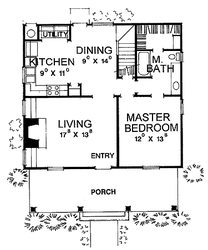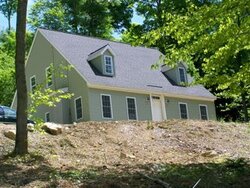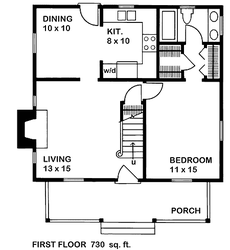jdrab9er said:
Here is a much better representation of my floor plan. Keep in mind the actual building size is 36x36. You would think w/ the location of the entrance to the master bedroom would make it easier to heat. But I tell you it was so cold back there, my wife and I slept on our mattress out in the living room.
Can you please explain the difference between the Dutchwest and the Firelight? Is the burn process that makes the difference in heat output? Or is it simply the fact that the Firelight's burn time is longer therefor putting out more BTU's per hour?
- Jon
Oh ho ho . . . this new floor plan changes things. Like BG and FWWarden I think I can safely say adding a fan on the floor of the hallway near the masterbedroom with the fan on the low setting and pointing towards the stove should make a difference in how warm the bedroom is this winter. As BG mentioned this is a simple and easy thing to try . . . if it works you can tell us later how smart we are . . . and if it doesn't you can feel free to berate us

or try cutting some vent holes in the walls or hook up to your heating system.
I suspect this will work though since many of us are able to heat our entire homes in this way . . . myself included . . . and incidentally I was wrong . . . I believe I may be heating my home (1970s vintage with 2 x 4 walls, insulated with fiberglass insulation . . . about 1,200 square feet on the ground floor) with an Oslo . . . which is as you may know the smaller brother to the Firelight.
So . . . differences between the DW and Jotul? Well, first of all . . . size does matter. There is a pretty big difference in stoves when you're talking 30,000 or so BTUs . . . not to mention that by going to the larger stove you've got a larger firebox which means the fire should in theory stay going longer. It would be surprising if you were not able to do a final reload of your stove around 9 or 10 at night and still have a warm firebox in the morning with enough coals to get the fire started around 5 or 6 in the morning. In fact, just thinking about the size . . . I'm heating my home in Maine and staying warm with the smaller Oslo . . . if anything you may find yourself to be too warm . . . although I suspect after sleeping in the living room and freezing last year you're willing to put up with it being too hot vs. freezing again this winter.
As to why the fan trick will work . . . yeah, it sounds ridiculously simple . . . and it is . . . but it works because you're taking a stove that primary heats an area through radiational heating (think of the heat as coming out from the stove in straight, direct lines and hitting objects in the room and heating them up) and introducing a convectional way of heating (i.e. using the fan to set up an artificial wind current) which will take the heat "trapped" in the room and slowly circulate it to other areas of the house.
And why didn't the DW work last year? It could be that it was too small for the job . . . or it could be that without a means to move the heat throughout the home the heat was either "trapped" in the living room . . . or the heat moved along until it reached the stairwell and then did what heat likes to do . . . it rose and heated the second floor . . . and bypassed the master bedroom. By setting up the air current you should be able to push the cooler air towards the stove . . . the air will be heated and then flow in to the area vacated by the cool air . . . setting up a loop. Incidentally, don't light a fire and expect the bedroom to be warmer within a few minutes . . . in my own case it takes a while to get the outer areas warm . . . and as FW mentioned the room with the stove is almost always the warmest room.
Finally, make sure you have good, well-seasoned wood . . . this is crucial for getting the most heat out of each load of wood . . . and be sure you know how to properly operate the stove -- secondary burning will result in a lot more heat than "free burning" (air lever left all the way open) . . . free burning looks pretty impressive with lots of flames, but a lot of the heat is simply escaping up the chimney and you're not getting secondary burns.





 or try cutting some vent holes in the walls or hook up to your heating system.
or try cutting some vent holes in the walls or hook up to your heating system.